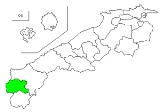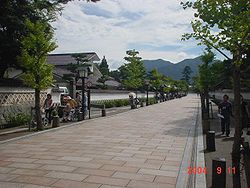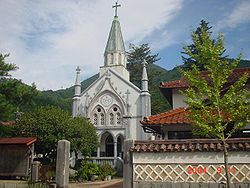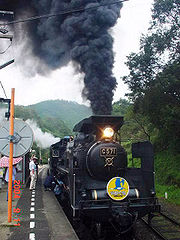
Tsuwano, Shimane
Encyclopedia

Towns of Japan
A town is a local administrative unit in Japan. It is a local public body along with prefecture , city , and village...
in Kanoashi District
Kanoashi District, Shimane
is a district located in Shimane, Japan.As of 2003, the district has an estimated population of 17,879 and a density of 27.79 persons per km². The total area is 643.38 km².-Mergers:...
, Shimane
Shimane Prefecture
is a prefecture of Japan located in the Chūgoku region on Honshū island. The capital is Matsue. It is the second least populous prefecture in Japan, after its eastern neighbor Tottori. The prefecture has an area elongated from east to west facing the Chūgoku Mountain Range on the south side and to...
Prefecture
Prefectures of Japan
The prefectures of Japan are the country's 47 subnational jurisdictions: one "metropolis" , Tokyo; one "circuit" , Hokkaidō; two urban prefectures , Osaka and Kyoto; and 43 other prefectures . In Japanese, they are commonly referred to as...
, Japan
Japan
Japan is an island nation in East Asia. Located in the Pacific Ocean, it lies to the east of the Sea of Japan, China, North Korea, South Korea and Russia, stretching from the Sea of Okhotsk in the north to the East China Sea and Taiwan in the south...
. As of 2003, the town has an estimated population
Population
A population is all the organisms that both belong to the same group or species and live in the same geographical area. The area that is used to define a sexual population is such that inter-breeding is possible between any pair within the area and more probable than cross-breeding with individuals...
of 8,878 and a density
Population density
Population density is a measurement of population per unit area or unit volume. It is frequently applied to living organisms, and particularly to humans...
of 28.9 persons per km². The total area is 307.09 km².
Tsuwano is remotely located and surrounded by hills. Though geographically closer to Yamaguchi
Yamaguchi, Yamaguchi
is the capital city of Yamaguchi Prefecture, Japan.As of February 1, 2010, the city has an estimated population of 198,971 and a population density of 194.44 persons per km²...
, the capital of Yamaguchi Prefecture
Yamaguchi Prefecture
is a prefecture of Japan in the Chūgoku region on Honshū island. The capital is the city of Yamaguchi, in the center of the prefecture. The largest city, however, is Shimonoseki.- History :...
, it is situated in Shimane Prefecture
Shimane Prefecture
is a prefecture of Japan located in the Chūgoku region on Honshū island. The capital is Matsue. It is the second least populous prefecture in Japan, after its eastern neighbor Tottori. The prefecture has an area elongated from east to west facing the Chūgoku Mountain Range on the south side and to...
. A train trip to Matsue
Matsue, Shimane
is the capital city of Shimane Prefecture in the Chūgoku region of Japan.As of August, 2011, the city has an estimated population of 207,000, following its most recent merging with Higashi-Izumo...
, Shimane’s capital, takes as long as four hours. Due to its proximity to the border to neighboring Yamaguchi, many tourists who come to Tsuwano also visit Hagi
Hagi, Yamaguchi
is a city located in Yamaguchi, Japan and was incorporated as a city on July 1, 1932. Formerly part of Abu District.On March 6, 2005, the former city of Hagi merged with the towns of Susa and Tamagawa, and the villages of Asahi, Fukue, Kawakami and Mutsumi to form the new city of Hagi.Iwami Airport...
on the Sea of Japan
Sea of Japan
The Sea of Japan is a marginal sea of the western Pacific Ocean, between the Asian mainland, the Japanese archipelago and Sakhalin. It is bordered by Japan, North Korea, Russia and South Korea. Like the Mediterranean Sea, it has almost no tides due to its nearly complete enclosure from the Pacific...
and Yamaguchi at the same time, and Tsuwano is often mistaken as being located in Yamaguchi prefecture for this reason.
Popularly called the "Little Kyoto of San-In," Tsuwano is known for its picturesque mainstreet, "Tono-machi," which is lined with Edo-era buildings and Koi ponds. It also boasts one of the oldest still in use "Yabusame" (horse back archery) ranges in all of Japan, and its annual Yabusame festival is a large tourist draw for the San-In region.
On September 25, 2005 the town of Nichihara
Nichihara, Shimane
was a town located in Kanoashi District, Shimane, Japan.On September 25, 2005 Nichihara was merged into the town of Tsuwano.As of 2003, the town had an estimated population of 4,255 and a density of 25.44 persons per km²...
was merged into Tsuwano.

Francis Xavier
Francis Xavier, born Francisco de Jasso y Azpilicueta was a pioneering Roman Catholic missionary born in the Kingdom of Navarre and co-founder of the Society of Jesus. He was a student of Saint Ignatius of Loyola and one of the first seven Jesuits, dedicated at Montmartre in 1534...
, who visited Japan as a missionary in 1549–50, and is located on its mainstreet. The church at Otome Pass is part of a memorial for Christians persecuted and tortured in Tsuwano by the government during the Edo and Meiji periods.
Other notable locations and tourist attractions within Tsuwano include the ruins of Tsuwano Castle, where the Kamei clan once ruled the Tsuwano fiefdom from the 17th through mid 19th-centuries, and the famed mountainside Taikodani Inari Shrine with its "1000 vermillion torii gates." In 1773 Tsuwano's seventh generation feudal lord Kamei Norisada had Taikodani Inari built to enshrine a share of the spirit worshipped at the Fushimi Inari in Kyoto. This shrine was built to pray for the safety of Kamei's castle and peace among his people.
Notable people
Novelist Mori ŌgaiMori Ogai
was a Japanese physician, translator, novelist and poet. is considered his major work.- Early life :Mori was born as Mori Rintarō in Tsuwano, Iwami province . His family were hereditary physicians to the daimyō of the Tsuwano Domain...
was born in Tsuwano into a family of doctors, and the house of his birth is preserved. Mori studied medicine in Germany
Germany
Germany , officially the Federal Republic of Germany , is a federal parliamentary republic in Europe. The country consists of 16 states while the capital and largest city is Berlin. Germany covers an area of 357,021 km2 and has a largely temperate seasonal climate...
and led the adoption of German medical practices into the Japanese military. In commemoration, Tsuwano became a sister city of Berlin's central ward under an agreement signed August 25, 1995. His tomb is located in Yomei Temple in Tsuwano, which was built in 1420 and is known as one of two great Sōtō
Soto
Sōtō Zen , or is, with Rinzai and Ōbaku, one of the three most populous sects of Zen in Japanese Buddhism.The Sōtō sect was first established as the Caodong sect during the Tang Dynasty in China by Dongshan Liangjie in the 9th century, which Dōgen Zenji then brought to Japan in the 13th century...
sect temples, the other being Daijo-ji Temple in Kanazawa city
Kanazawa, Ishikawa
is the capital city of Ishikawa Prefecture, Japan.-Geography, climate, and population:Kanazawa sits on the Sea of Japan, bordered by the Japan Alps, Hakusan National Park and Noto Peninsula National Park. The city sits between the Sai and Asano rivers. Its total area is 467.77 km².Kanazawa's...
.
Philosopher Nishi Amane
Nishi Amane
was a philosopher in Meiji period Japan who helped introduce Western philosophy into mainstream Japanese education.-Early life:Nishi was born in Tsuwano Domain of Iwami Province as the son of a samurai physician who practiced Chinese medicine...
, another leader of Japan’s modernization in the Meiji period
Meiji period
The , also known as the Meiji era, is a Japanese era which extended from September 1868 through July 1912. This period represents the first half of the Empire of Japan.- Meiji Restoration and the emperor :...
, was also born in Tsuwano. His ancestors were physicians for the daimyo
Daimyo
is a generic term referring to the powerful territorial lords in pre-modern Japan who ruled most of the country from their vast, hereditary land holdings...
of the fief
Han (Japan)
The or domain was the name of the estate belonging to a warrior in Japan after the 17th century. The fiefs of the daimyos of the samurai class of Japan during the Edo period were called han.-Edo period:...
.
Tsuwano has two new art galleries to celebrate artistic sons. One, the Anno Art Museum (opened in 2001), is dedicated to Mitsumasa Anno
Mitsumasa Anno
is a Japanese author and illustrator of children's books.-Background:Anno was born in 1926 in Japan, and grew up in the small town of Tsuwano. As a student at a regional high school, he studied art, drawing, and the writings of Hermann Hesse. During World War II, Anno was drafted into the...
, who was born and raised in Tsuwano. The other is the Shisei Kuwabara Photographics Museum, the name since April 1, 2004 of what was previously the Tsuwano Documentary Photograph Gallery; this features photographs by and is named after Shisei Kuwabara
Shisei Kuwabara
is a photojournalist best known for his depiction of the effects of mercury poisoning on people in and near Minamata over a period of some forty years....
, famous for his work in Minamata
Minamata, Kumamoto
is a city located in Kumamoto prefecture, Japan. It is on the west coast of Kyūshū. The city was founded on April 1, 1949.As of 2008, the city has an estimated population of 27,856 and the density of 171 persons per km²...
and Korea.
Rie Fujii
Rie Fujii
is a Japanese woman who abandoned her two infant children in an apartment in Calgary, Alberta while she visited her boyfriend. On her return ten days later, she found both children dead....
(b.1971) is also from Tsuwano. In 2001, Fujii abandoned her two infant children in their apartment in Calgary, Alberta. She returned to the apartment after ten days, at which time she found both infants had died of starvation and/or dehydration
Dehydration
In physiology and medicine, dehydration is defined as the excessive loss of body fluid. It is literally the removal of water from an object; however, in physiological terms, it entails a deficiency of fluid within an organism...
. Fujii was convicted of manslaughter
Manslaughter
Manslaughter is a legal term for the killing of a human being, in a manner considered by law as less culpable than murder. The distinction between murder and manslaughter is said to have first been made by the Ancient Athenian lawmaker Dracon in the 7th century BC.The law generally differentiates...
in a Canadian court
Court system of Canada
The court system of Canada is made up of many courts differing in levels of legal superiority and separated by jurisdiction. Some of the courts are federal in nature while others are provincial or territorial....
, and served five years of an eight year sentence, after which she was deported to Japan.
Yamaguchi-gō steam locomotive

Tourism
Tourism is travel for recreational, leisure or business purposes. The World Tourism Organization defines tourists as people "traveling to and staying in places outside their usual environment for not more than one consecutive year for leisure, business and other purposes".Tourism has become a...
destination, Tsuwano is served by the steam locomotive
Steam locomotive
A steam locomotive is a railway locomotive that produces its power through a steam engine. These locomotives are fueled by burning some combustible material, usually coal, wood or oil, to produce steam in a boiler, which drives the steam engine...
Yamaguchi-gō, which runs once daily on weekends, national holidays, and certain other days between March and November (daily in August) on the Yamaguchi Line
Yamaguchi Line
The is a railway line operated by West Japan Railway Company in western Japan connecting Shin-Yamaguchi Station in Yamaguchi, Yamaguchi Prefecture and Masuda Station in Masuda, Shimane Prefecture.-Basic data:*Operator:*Gauge: 1,067 mm...
from Shin-Yamaguchi Station
Shin-Yamaguchi Station
is a station operated by West Japan Railway Company in Yamaguchi, Yamaguchi, and is a stopping point for the Sanyō Shinkansen and the Sanyō Main Line, and serves as termini of Yamaguchi Line and Ube Line...
to Tsuwano and back.http://www.c571.jp/jouhoukyoku/timetable/timetable.html It stops for about three hours in Tsuwano before returning to Shin-Yamaguchi station. The train is usually pulled by a C57 locomotive, but a C56 does the job on several weekdays between July and September, and both engines are linked in a double-header configuration on weekends in August. Carriages are decorated in the styles of three Japanese eras—Meiji, Taisho, and Showa—as well as in European style, and the rear-most carriage has an outdoor observation deck.
A scene in director Masahiro Shinoda
Masahiro Shinoda
is a Japanese film director, originally associated with the Shochiku Studio, who came to prominence as part of the Japanese New Wave in the 1960s.-Career:...
’s Spy Sorge, a 2003 movie about Soviet
Soviet Union
The Soviet Union , officially the Union of Soviet Socialist Republics , was a constitutionally socialist state that existed in Eurasia between 1922 and 1991....
spy Richard Sorge
Richard Sorge
Richard Sorge was a German communist and spy who worked for the Soviet Union. He has gained great fame among espionage enthusiasts for his intelligence gathering during World War II. He worked as a journalist in both Germany and Japan, where he was imprisoned for spying and eventually hanged....
, was shot on the train for period effect.

